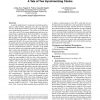Free Online Productivity Tools
i2Speak
i2Symbol
i2OCR
iTex2Img
iWeb2Print
iWeb2Shot
i2Type
iPdf2Split
iPdf2Merge
i2Bopomofo
i2Arabic
i2Style
i2Image
i2PDF
iLatex2Rtf
Sci2ools
SENSYS
2009
ACM
2009
ACM
A tale of two synchronizing clocks
A specific application for wastewater monitoring and actuation, called CSOnet, deployed city-wide in a mid-sized US city, South Bend, Indiana, posed some challenges to a time synchronization protocol. The nodes in CSOnet have a low duty cycle (2% in current deployment) and use an external clock, called the Real Time Clock (RTC), for triggering the sleep and the wake-up. The RTC has a very low drift (2 ppm) over the wide range of temperature fluctuations that the CSOnet nodes have, while having a low power consumption (0.66 mW). However, these clocks will still have to be synchronized occasionally during the long lifetime of the CSOnet nodes and this was the problem we confronted with our time synchronization protocol. The RTC to fit within the power and the cost constraints makes the tradeoff of having a coarse time granularity of only 1 second. Therefore, it is not sufficient to synchronize the RTC itself—that would mean a synchronization error of up to 1 second would be possib...
| Added | 23 Jul 2010 |
| Updated | 23 Jul 2010 |
| Type | Conference |
| Year | 2009 |
| Where | SENSYS |
| Authors | Jinkyu Koo, Rajesh Krishna Panta, Saurabh Bagchi, Luis Antonio Montestruque |
Comments (0)

